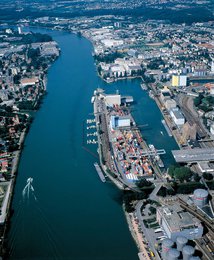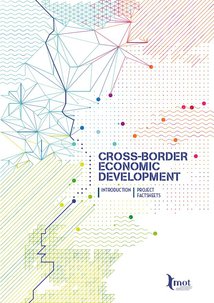Economic development
Overview
European context and issues concerning cross-border economic development
Contributing to the Europe 2020 strategy
The financial, then economic crisis, having affected the European Union and its economy since 2008, has contributed to the demand for a strategic approach for the 2014-2020 European programming period, in order to overcome the economic situation and contribute to the creation of growth and jobs, without losing sight of the other objectives of EU cohesion policy.
The Europe 2020 strategy1, adopted in 2010 following the Lisbon Strategy (2000-2010), is intended to enable the European Union to emerge stronger from the crisis and steer its economy towards smart, sustainable and inclusive growth. Under the corresponding guidelines for the actions of Member States, five principal joint objectives are listed, including several directly related to economic development, (cf. employment, research and development, innovation, education, etc.).
Cross-border territories are naturally at the heart of the issues addressed in the Europe 2020 strategy and EU funds are effectively contributing to the achievement of these goals. Thus among the 11 thematic objectives of the forthcoming General Regulation, the third is "Enhancing the competitiveness of small and medium enterprises."2
The Regulation (EU) n° 1301/2013, supported by the Commission’s November 2015 document “European Structural and Investment Funds 2014-2020: official texts and commentaries”, lays down the specific provisions concerning the activities eligible for ERDF support and provides a list of common implementation indicators. The role of the ERDF consists of strengthening economic, social and territorial cohesion by tackling the principal regional disparities within the EU.
Also adopted in June 2008 and reviewed in February 2011, the "Small Business Act"3 for Europe reflects the desire of the European Commission to acknowledge the vital role played by SMEs in the European economy. It establishes for the first time a comprehensive policy framework for the EU and Member States.
Finally, the, Single Market Act presented by the European Commission in April 2011 specifies twelve levers to boost growth and strengthen confidence. In October 2012, the European Commission proposed a second package of measures (The Single Market Act II) to continue to develop the single market and exploit its potential for growth.4
challenges for cross-border territories
For cross-border cooperation in the field of economic development, tax, salary and price differentials, and linguistic, administrative, and cultural diversity etc., are constraints but also opportunities, depending on the perspective from which they are considered. Households and businesses take advantage of these differentials in their choice of location and use of markets (including the labour market) on the other side of the border. For both the labour force and businesses, the mastery of two languages, two cultures, two administrative environments, etc., is an asset that can broaden their horizons, not only within the cross-border territory, but more broadly to the whole of the two or three countries concerned, and beyond to the European or global level.
Companies, like territories are in competition, within national spaces, and all the more so in a cross-border context. In their efforts to support economic development, public authorities often remain within the national framework. Yet by participating in the European Union, the States have chosen to cooperate. This cooperation does not have to develop only through a "top-down" process between states and the European institutions. It can also develop from the bottom up, between citizens, businesses, local authorities, universities, etc. Cross-border territories, by their very nature, are becoming laboratories of European integration.
As larger businesses are more readily disposed to take account of the international and, therefore, cross-border dimension, this reflection mainly concerns SMEs, as their internationalisation is a major challenge. Medium-sized enterprises, with their greater capacity for innovation due to easier access to finance (own and external funds) and their flexibility for risk-taking, are lacking in France, when compared with Germany, Italy or the United Kingdom. Even so, internationalisation is not the only issue, as larger firms also have a social responsibility towards regional and, in particular, cross-border development.
Cross-border component of the SRDEII: a first step in taking into account cross-border potential in France
The NOTRe law (laying down a “new territorial organisation of the Republic”) made obligatory the elaboration by French regions of Regional Plans for Economic Development, Innovation and Internationalisation (SRDEII). This economic and strategic planning document must set out the guidelines around business support, support for internationalisation and aid for businesses’ innovation and property investment.
Following an amendment proposed in the Senate by the President of the MOT Michel Delebarre, regions have the possibility of integrating a cross-border component in SRDEIIs.
The regions have taken this opportunity to carry out an economic diagnostic survey of their territories, including the cross-border challenges and identifying the opportunities and dynamics of cooperation. This type of exercise is very beneficial for facilitating the organisation of processes of economic governance for cross-border territories and starting to think about economic development in cross-border contexts in an integrated manner.
External action of local and regional authorities and economic diplomacy:
The White Paper on Local and Regional Diplomacy (Diplomatie des Territoires), formulated by the French National Commission for Decentralised Cooperation (CNCD) allows the networking of stakeholders supporting SME-SMI exports and the attractiveness of territories, in order to boost the economic potential of decentralised cooperation conducted by local authorities. More than 80% of decentralised cooperation actions are carried out with developed countries, and this therefore concerns cross-border cooperation. The MOT is recognised in the white paper as a tool for supporting these strategies.
- COM(2010) 2020, of 3 March 2010 : in 2010, the European Council adopted a strategy for the Europe of 2020, aiming to stimulate smart, sustainable and inclusive growth.
See also : the Council Recommendation of 13 July 2010 on broad guidelines for the economic policies of the Member States and of the Union (JO L 191 of 23.7.2010, p. 28) and the Council Decision of 21 October 2010 on guidelines for the employment policies of the Member States (JO L 308 du 24.11.2010, p. 46). - Economic development touches upon many areas and requires a comprehensive approach, including a close link with the Thematic Objectives “Strengthening research, technological development and innovation” or those concerning employment, infrastructure, public administration, etc. See also the factsheets on the topics of Research and innovation and Employment.
- The Small Business Act is a set of ten principles intended to guide the design and implementation of policies both at EU and national level for the improvement of the administrative and legal environment for SMEs.
- For further reading see also the "Strategic document on Smart cooperation - Territorial Cooperation fostering European integration: Cities and Regions linking across borders” realised in 2012 by the CECICN, Conference of European Cross-border and Interregional City Networks, of which the MOT is a founding member, along with the AEBR.



